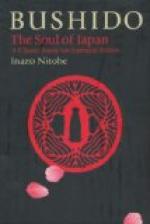[Footnote 11: Theory of the Leisure Class, N.Y. 1899, p. 46.]
I have heard slighting remarks made by Europeans upon our elaborate discipline of politeness. It has been criticized as absorbing too much of our thought and in so far a folly to observe strict obedience to it. I admit that there may be unnecessary niceties in ceremonious etiquette, but whether it partakes as much of folly as the adherence to ever-changing fashions of the West, is a question not very clear to my mind. Even fashions I do not consider solely as freaks of vanity; on the contrary, I look upon these as a ceaseless search of the human mind for the beautiful. Much less do I consider elaborate ceremony as altogether trivial; for it denotes the result of long observation as to the most appropriate method of achieving a certain result. If there is anything to do, there is certainly a best way to do it, and the best way is both the most economical and the most graceful. Mr. Spencer defines grace as the most economical manner of motion. The tea ceremony presents certain definite ways of manipulating a bowl, a spoon, a napkin, etc. To a novice it looks tedious. But one soon discovers that the way prescribed is, after all, the most saving of time and labor; in other words, the most economical use of force,—hence, according to Spencer’s dictum, the most graceful.
The spiritual significance of social decorum,—or, I might say, to borrow from the vocabulary of the “Philosophy of Clothes,” the spiritual discipline of which etiquette and ceremony are mere outward garments,—is out of all proportion to what their appearance warrants us in believing. I might follow the example of Mr. Spencer and trace in our ceremonial institutions their origins and the moral motives that gave rise to them; but that is not what I shall endeavor to do in this book. It is the moral training involved in strict observance of propriety, that I wish to emphasize.
I have said that etiquette was elaborated into the finest niceties, so much so that different schools advocating different systems, came into existence. But they all united in the ultimate essential, and this was put by a great exponent of the best known school of etiquette, the Ogasawara, in the following terms: “The end of all etiquette is to so cultivate your mind that even when you are quietly seated, not the roughest ruffian can dare make onset on your person.” It means, in other words, that by constant exercise in correct manners, one brings all the parts and faculties of his body into perfect order and into such harmony with itself and its environment as to express the mastery of spirit over the flesh. What a new and deep significance the French word bienseance[12] comes thus to contain!
[Footnote 12: Etymologically well-seatedness.]




